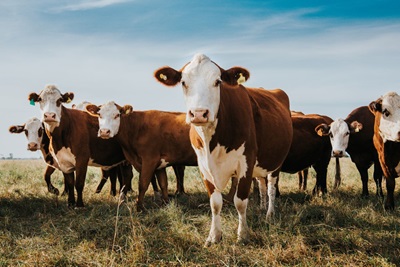
The creation of labels in the agriculture industry goes beyond mere aesthetics. It's a central part of responsible business practices and operational efficiency for businesses in the agriculture space. From health concerns to environmental consciousness, labels in agriculture serve as a bridge between the farm and the consumer and help establish a relationship built on trust and transparency. As the agricultural landscape continues to evolve, the role of labels will only become more important in shaping the future of food production and consumption.
This blog will go over common types of agriculture labeling including food, sustainability, and traceability labeling, common types of agriculture labels, and best practices.
Download a free trial of agriculture labeling software
Food product labeling is one of the most common types of agricultural labeling. Food labels are required to include certain information, including allergens, nutritional value, and where the food originated from.
Allergen labeling: Labels in agriculture, particularly on food products, must carry information about potential allergens, allowing individuals to make informed choices and avoid products that might trigger allergic reactions. The US Food Allergen Labeling and Consumer Protection Act (FALCPA) requires that labels on food products prominently display the presence of any ingredient from one of nine food allergens. Incorrect packages or labels that fail to identify allergens are the leading cause of food recalls by the FDA and the US Department of Agriculture (USDA).
Nutrition labeling: In an era where health consciousness is on the rise, nutritional information on labels is paramount. Agriculture labels break down the nutritional content of products, enabling consumers to select items that align with their dietary requirements and preferences. This information includes the number of calories, fat, carbohydrates, protein, and other nutrients in the product. Learn more about nutrition labeling in North America.
Country of origin labeling: Country of origin labeling (COOL) tells consumers where a food product was grown, raised, or produced. This information can be important to consumers who want to support local farmers or who want to avoid products from certain countries. The U.S. Customs and Border Protection (CBP) requires every foreign product entering the U.S. to have COOL in English, clearly and visibly located on the product, and written legibly and permanently.
Sustainability labeling provides consumers with information about the environmental and social impact of agricultural products. This information can include the product's organic certification, genetically modified organism (GMO) status, and pesticide use. 
Organic labeling: Organic labeling indicates that a product was produced using organic farming methods. Organic farming methods avoid the use of synthetic pesticides and fertilizers. If you want to claim that your product is organic on your labels or packaging and use the USDA organic seal, your product must be certified by an authorized certifying agent.

GMO labeling: The National Bioengineered Food Disclosure Law requires all foods produced with bioengineered ingredients, or GMOs, to be labeled as such. GMOs are plants or animals that have had their genetic makeup altered in a way that does not occur naturally. If your product does contain GMOs, packaging must include a small seal or text that says “bioengineered,” or “derived from bioengineering.”
Pesticide and chemical labeling: Labels are a tool for transparency when it comes to the use of pesticides and chemicals in agriculture. This information can be important to consumers who are concerned about the health and environmental impact of pesticides and chemicals. Plus, unlike other types of product labels, pesticide labels are legally enforceable. The U.S. Environmental Protection Agency (EPA) requires a pesticide label statement and using a pesticide in a way inconsistent with its label is a violation of the Federal Insecticide, Fungicide and Rodenticide Act (FIFRA).
Traceability labeling provides consumers with information about the journey that an agricultural product has taken through the supply chain and helps agriculture businesses easily identify products that are contaminated or have been recalled.
Trace products across supply chain: Traceability is a critical aspect of ensuring the safety and quality of agricultural products. Labels facilitate the traceability of products from farm to table, creating accountability and ensuring any issues can be swiftly identified and addressed.
Smart labels for consumers: Smart labels are a type of traceability labeling that uses digital technology to provide consumers with information about agricultural products. Smart labels contain a 2D barcode that can be scanned with a smartphone or other device to access information such as the product's origin, nutritional value, and sustainability practices.

Animal identification: In the field of animal agriculture, identification labels play a crucial role in traceability and disease control. From farm to fork, labels on animal products help in monitoring and managing the health and safety of the food supply chain. Animal identification labeling also supports breeding programs and serves as a deterrent against livestock theft.
There are a wide variety of products in the agriculture industry that each have their own labeling requirements, so it’s important to check your local, state, and international regulations for your specific product type. Below are labeling requirements for different agricultural products.
Seeds: Seeds are labeled to provide information about the type of seed, planting instructions, and potential hazards. This information is important for farmers and gardeners to ensure successful crop cultivation.
Animal feed: Animal feed is labeled to provide information about the nutritional content, feeding instructions, and any additives or medications present in the feed. This information is important for ensuring the health and productivity of livestock.
Aquaculture products (seafood): Seafood labels provide information about the origin, sustainability, and safety of the product. This information helps buyers to make ethical and health-conscious choices.
Dairy products: Dairy product labels provide information about the nutritional content, fat content, and any additives or processing methods used. This information is important for consumers to make informed choices about the dairy products they consume.
Grains: Grain labels provide information about the nutritional content, milling type, and any potential allergens. This information is important for consumers to make informed choices about the grains they consume.
Animal products: Animal product labels provide information about the type of animal, country of origin, and any processing methods used.
Honey and bee products: Honey and bee product labels provide information about the type of honey, country of origin, and any processing methods used.
Soil: Soil labels provide information about the soil type, nutrient content, and pH level. This information is important for farmers and gardeners to choose the right soil for their crops.
With all the regulations that come with agriculture labeling, having reliable barcode labeling software is a must. TEKLYNX software solutions can help you stay compliant. Use CODESOFT for RFID barcode label design, document printing, and LABEL ARCHIVE for full control of product traceability.
Get in touch about software for agriculture labeling
Travis Wayne is the Product Manager at TEKLYNX. Travis applies his 20+ years of IT and health sciences experience to empower businesses to streamline operations and barcode better by applying software and technology. He works to continually improve TEKLYNX strategic planning, product and project management principles, and cross-functional communications. When not working, he enjoys many outdoor activities with his wife and two children.
This blog goes over food safety labeling regulations, prepping for the FDA’s FSMA Section 204, the importance of label accuracy for recall prevention, and if a recall is unavoidable, how labeling solutions help identify the products to remove from the supply chain.
READ MORE
When it comes to the food and beverage industry, it is incredibly important to have the best label software in place to ensure efficiency, stability, and peace of mind throughout the supply chain.
READ MORE
Whether you’re in the food industry or are an avid grocery shopper, you know that barcode labels play an important role on food. From nutrition facts and allergen labeling to food supply chain traceability, the food labeling world is full of information that is necessary for each and every food label is full of necessary information.
READ MORE
What do you think? Leave us a comment.
Comments will be reviewed and are subject to TEKLYNX’ comment policy. Your email address will not be published publicly.